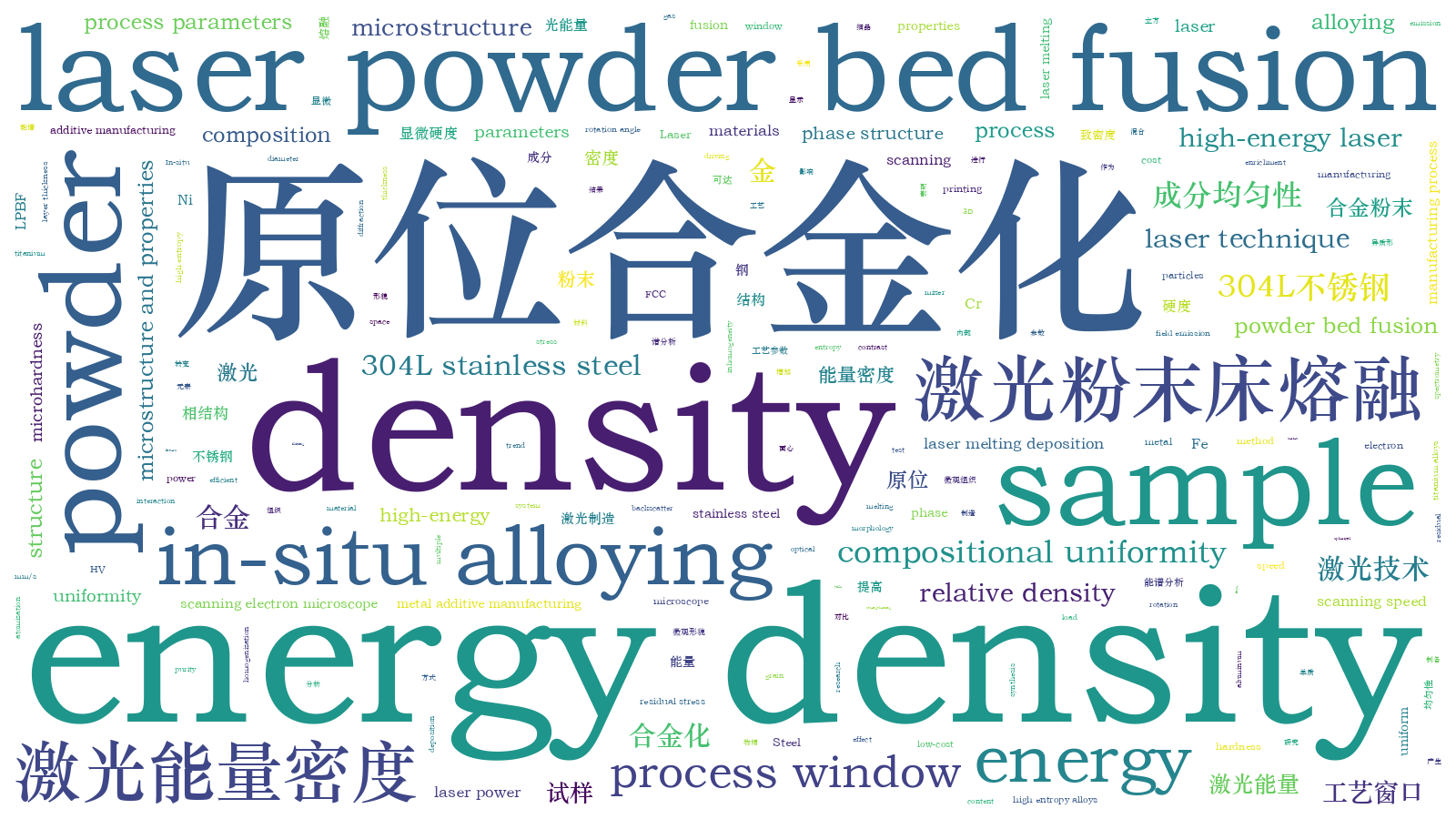304L不锈钢的激光粉末床熔融原位合金化  下载: 638次封面文章
下载: 638次封面文章
Laser powder bed fusion (LPBF) and laser melting deposition (LMD) are the main processes of metal additive manufacturing. The powder materials used for LPBF or LMD are normally spherical pre-alloyed powders. The high difficulty and cost have limited the number of powder brands available commercially. In-situ alloying, which utilizes different pure elements or alloy powders as raw materials to produce synthesis block alloys, is an efficient and low-cost research method that utilizes the interaction between high-energy laser and powder during the additive manufacturing process. Recently, in-situ alloying of titanium alloys, aluminum alloys, nickel-based superalloys, steel, and high entropy alloys has been explored. 300 series stainless steel is one of the earliest commercial LPBF materials with excellent printing properties. Nevertheless, there are few reports on preparing this material system by elemental powder in-situ alloying. This study examined 304L stainless steel and fabricated multiple groups of block samples with different processes by LPBF in-situ alloying using the elemental mixed powder to explore the effects of the LPBF process parameters on the microstructure and properties of the in-situ alloying samples.
Spherical Fe, Cr, Ni elemental blended powder, and 304L pre-alloyed powder prepared by gas atomization were used as the raw materials. The elemental powder was >99.5% purity and was mixed using a rotary mixer. The samples were prepared using a DLM-280 metal 3D printer produced by Hangzhou DediBot. The laser power and scanning speed were used as variables. For the elemental blended powder, laser powers (W) of 80, 110, 140, 170, 200, 230, 260, and 290, and the scanning speeds (mm/s) of 500, 650, 800, 950, 1100, and 1250, and 48 groups of parameters were selected. For the 304L pre-alloyed powder, the laser power and scanning speed were 230 W and 650 mm/s, respectively. The other parameters were constant: spot diameter of 80 μm, layer thickness of 30 μm, hatching space of 80 μm, and rotation angle of 90° between layers. The sample density was calculated using the Archimedes drainage method. An Olympus BX53 optical microscope and FEI Quanta650 field emission scanning electron microscope were used to characterize the microstructure of the sample. Energy dispersive spectrometry and electron backscatter diffraction were conducted to investigate the elemental content and microstructure. An EM500-2A hardness tester was used to test the microhardness of the samples, and each sample was tested at 16 points with a load of 4.9 N and a loading time of 15 s.
The process window was plotted according to the measured density of the in-situ alloyed sample (Fig. 3). The density of the sample showed a converging trend. The maximum density of the sample was 7.855 g/cm3 at an energy density of 147 J/mm3 (P=230 W, v=650 mm/s), and the corresponding relative density was 99.05%, which was comparable to the sample prepared from the 304L pre-alloyed powder. When the energy density was 71 J/mm3, many lack-of-fusion holes and unmelted particles were observed in the in-situ alloyed sample (Fig. 4). With increasing energy density, the lack-of-fusion holes and unmelted particles gradually disappeared. A typical cellular structure and columnar grains could be observed in the sample when the energy density was 242 J/mm3 (Fig. 5). In terms of composition uniformity, with increasing energy density, the macroscopic and microscopic homogenization driving force of the in-situ alloyed samples during the LPBF process was strengthened, so the composition uniformity was improved. The composition was uniform when the energy density was 242 J/mm3 (Fig. 6). Owing to Fe, Cr, and Ni enrichment zones, the in-situ alloying samples consisted of a face-centered cubic (FCC) and body-centered cubic (BCC) duplex when the energy density was 147 J/mm3. By contrast, the sample consisted of an FCC single phase when the energy density was increased to 242 J/mm3, which is the same as the sample prepared from the 304L pre-alloyed powder (Fig. 8). With increasing energy density, the strengthening effect of fine-grains, duplex structure, dislocations, and residual stress caused by composition inhomogeneity was weakened, and the microhardness of the in-situ alloyed samples decreased gradually from 302 HV to 224 HV (Fig. 10).
The in-situ alloyed 304L stainless steel sample with a uniform microstructure was prepared by LPBF technology using Fe, Cr, and Ni mixed powder. The effects of the process parameters on the density, microstructure morphology, composition uniformity, phase structure, and microhardness of the sample were studied and compared with the LPBF sample fabricated using pre-alloyed 304L powder. The results showed that the density of the in-situ alloyed sample converged gradually in the process window and reached the highest value of 7.855 g/cm3 when the energy density was 147 J/mm3 (P=230 W, v=650 mm/s). The corresponding relative density was 99.05%, indicating that the elemental mixed powder has excellent LPBF printing properties. With increasing energy density, the uniformity of composition was improved; the phase structure changed from FCC + BCC to FCC, and the microhardness gradually decreased from 302 to 224 HV. When the energy density was 242 J/mm3, the average value of each element in the sample reached the proportion of powder mixing, indicating a uniform composition of the structure. The process parameters of LPBF significantly affect the microstructure of the sample. The multiphase structure and fine grain structure generated by hyperinflation in the in-situ alloying samples at a low energy density can improve the hardness of the sample by up to 26.4% compared to the pre-alloyed LPBF sample.
张浩, 侯雅青, 王炫东, 苏航. 304L不锈钢的激光粉末床熔融原位合金化[J]. 中国激光, 2023, 50(4): 0402001. Hao Zhang, Yaqing Hou, Xuandong Wang, Hang Su. In-Situ Alloying of 304L Stainless Steel by Laser Powder Bed Fusion[J]. Chinese Journal of Lasers, 2023, 50(4): 0402001.







